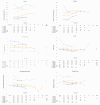Predictive haemostatic biomarkers and transfusion efficacy, insights from fresh frozen plasma use in surgical patients, preliminary results
- PMID: 39522009
- PMCID: PMC11549873
- DOI: 10.1186/s13104-024-06992-5
Predictive haemostatic biomarkers and transfusion efficacy, insights from fresh frozen plasma use in surgical patients, preliminary results
Abstract
The aim of the study was to examine various haemostasis values to identify the most relevant biological indicators for detecting significant haemorrhage, to determine the effectiveness of fresh frozen plasma (FFP) transfusion. Our findings suggest that a low prothrombin time, elevated Von Willebrand Antigen, increased plasma fibrinogen, and reduced Ca2 + levels are associated with challenges in achieving proper haemostasis. However, measurements of factors II, V, VII, VIII, IX, X, XI, XIII, protein C, and protein S do not appear to be linked to difficulties in achieving adequate haemostasis. Additionally, the administration of FFP appears to impact factors V, VII, X, and II.Trial registration EudraCT number: 2019-002898-64.
Keywords: Fresh frozen plasma; Haemostasis; Transfusion threshold; Transfusion yield.
© 2024. The Author(s).
Conflict of interest statement
The authors declare no competing interests.
Figures




Similar articles
-
Effects of solvent/detergent-treated plasma and fresh-frozen plasma on haemostasis and fibrinolysis in complex coagulopathy following open-heart surgery.Vox Sang. 2002 Jan;82(1):9-14. doi: 10.1046/j.1423-0410.2002.00129.x. Vox Sang. 2002. PMID: 11856461 Clinical Trial.
-
Perioperative dilutional coagulopathy treated with fresh frozen plasma and fibrinogen concentrate: a prospective randomized intervention trial.Vox Sang. 2012 Jul;103(1):25-34. doi: 10.1111/j.1423-0410.2011.01575.x. Epub 2011 Dec 28. Vox Sang. 2012. PMID: 22211833 Clinical Trial.
-
Comparison of albumin, colloid osmotic pressure, von Willebrand factor, and coagulation factors in canine cryopoor plasma, cryoprecipitate, and fresh frozen plasma.J Vet Emerg Crit Care (San Antonio). 2017 Nov;27(6):638-644. doi: 10.1111/vec.12671. Epub 2017 Oct 24. J Vet Emerg Crit Care (San Antonio). 2017. PMID: 29064153
-
Perioperative factor concentrate therapy.Br J Anaesth. 2013 Dec;111 Suppl 1:i35-49. doi: 10.1093/bja/aet380. Br J Anaesth. 2013. PMID: 24335398 Review.
-
Pediatric hemostasis and use of plasma components.Best Pract Res Clin Haematol. 2006;19(1):143-55. doi: 10.1016/j.beha.2005.03.006. Best Pract Res Clin Haematol. 2006. PMID: 16377547 Review.
References
-
- Kozek-Langenecker SA, Ahmed AB, Afshari A, et al. Management of severe perioperative bleeding: guidelines from the European society of anaesthesiology: first update 2016. Eur J Anaesthesiol. 2017;34(6):332–95. 10.1097/EJA.0000000000000630. - PubMed
-
- Levi M, ten Cate H. Disseminated intravascular coagulation. N Engl J Med. 1999;341(8):586–92. 10.1056/NEJM199908193410807. - PubMed
-
- Practice Guidelines for Perioperative Blood ManagementAn Updated Report by the American Society of Anesthesiologists Task Force on Perioperative Blood Management*. Anesthesiol J Am Soc Anesthesiol. 2015;122(2):241–275. 10.1097/ALN.0000000000000463 - PubMed
MeSH terms
Substances
LinkOut - more resources
Full Text Sources
Miscellaneous

